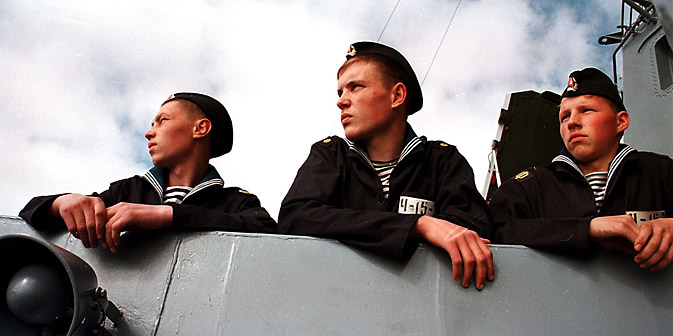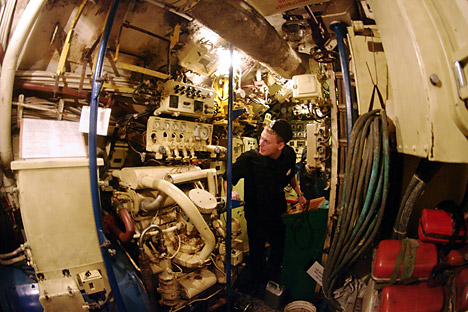Two months underwater: The life of a Russian submariner

Nearly every submarine has two crews. As one crew goes on mandatory leave after each sea voyage, the other takes over. Voyages vary in length from 50 to 90 days. Source: Reuters
The first dive
Every submarine crew member must undergo an initiation rite. Mine was the basic procedure of having to drink seawater from a lamp dome. Seawater tastes very bitter and mouth puckering. Then I was issued with a hand-drawn submariner certificate.
On some boats, this rite is accompanied by the so-called sledgehammer kiss: you must kiss a sledgehammer suspended from the ceiling as the boat rocks.
I'm hard pressed to find any sense in this particular procedure, but you don't argue on a boat – this is the first rule you learn as you step onboard.
The service

Each missile carries 10 individually targeted warheads. Each warhead is equivalent to five or six Hiroshima bombs. Source: AFP / East News
Nearly every submarine has two crews. As one crew goes on mandatory leave after each sea voyage, the other takes over. Voyages vary in length from 50 to 90 days.
First comes the drill part, which may include communicating with another boat while submerged, diving to the maximum depth, and practice firing. If all the practical exercises have been passed, the boat proceeds to the combat patrol phase.
During my time we spent most of the time patrolling under the North Pole ice cap so the submarine could not be detected from space. In clear waters, a boat can be seen by satellites even if proceeding at a depth of 100 meters.
Our mission was to patrol an area in constant combat readiness, and be prepared to use our weapons if ordered to do so. A single submarine with 16 ballistic missiles can annihilate Great Britain, for example.
Each missile carries 10 individually targeted warheads. Each warhead is equivalent to five or six Hiroshima bombs. So we would spend weeks on end sitting on 800 Hiroshimas.
The boat life

Living in an enclosed space is easer with good team. Source: RIA Novosti
Living in an enclosed space is not as difficult as it may sound, mostly because the eight-hour shifts keep you busy most of the time. Every day, at around three o'clock in the afternoon, everyone has to clean their assigned areas.
Some have an instrument panel to dust, others have to clean the heads – the toilets – in the bow.
The most disappointing thing is that once you have been assigned an area to clean, you stick with it for the entire period of your service. So if you are the heads guy you will clean the heads every day.
The food
Submariners' rations are very nutritious. We usually had cottage cheese, honey, and jam for breakfast; the dinner meal would necessarily include red caviar and cured sturgeon fillet. The daily norm includes 100 grams of dry red wine, a chocolate bar, and some stock-fish.
Back in the Soviet times, when there was a discussion on how to improve submariners' appetite, the medical commission split between beer and wine. The wine gang won, but stock-fish, which normally goes well with beer, still made its way into the rations for some reason.
The regulations
The drill regulations are the fundamental law on board. Sometimes they are observed so rigorously it may get ridiculous. According to Article 33 of the Russian Armed Forces Drill Regulations, a serviceman is allowed to run only when commanded: "Double time, march!"
Once, the deputy division commander decided to visit the heads, only to find the door locked. He told the first mate to unlock it. The first mate, who was sitting with his back to the senior rank and did not react.
The senior officer repeated the request: "First mate, go bring the key, double time!" Still no reaction. "Double time! Can't you hear me? I told you double time, what are you waiting for?" The first mate replied: "I am waiting, Comrade Captain 1st Rank, for you to command 'March!'"
The commanders
There are different commanders, but each of them must instill awe, so you would realize that if you disobeyed their orders or tried arguing with them, a reprimand would be your least severe punishment.
The most colorful character among my commanders was Capt. First Rank Gaponenko. Once he came down from the bridge, looked at us, and asked: "What are you guys up to?" We replied that we were practising formation maneuvers, and were about to coordinate actions with the other boat, No 685.
Suddenly, the commander reached for the mike: "No. 681 to 685, please kill your engine." The reply came instantly: "No. 685 to 681, unable, over." Gaponenko didn't like this at all. "Kill your engine now, it's an order!"
An even more insistent reply came: "Repeat, unable to comply, over." Gaponenko flew right off the handle: "I am ordering you to kill your engine, right now, do you hear me? It's Capt. First Rank Gaponenko speaking! I'll hang you out to dry when you return to base!" Uneasy silence fell.
Then the radioman, who was half dead with fear, whispered: "Comrade Captain 1st Rank, I am sorry, it was my mistake. We need to coordinate with No 683; No 685 is an aircraft." Gaponenko broke the communications panel in wrath, stormed out, and stayed in his quarters until we surfaced.
First published in Russian in The Village.
All rights reserved by Rossiyskaya Gazeta.
Subscribe
to our newsletter!
Get the week's best stories straight to your inbox

